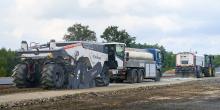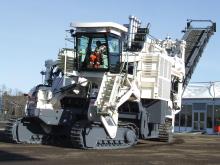
The WRC 240(i) breaks coarse rocks in-situ, as found in hand-packed pavement layers (e.g. Telford bases) or stony soils, and produces a homogeneous mix in a continuous process. The working width of 2,320 mm and a working depth of up to 510 mm enables an output of up to 600 tonnes per hour. The market launch of the Rock Crusher will take place in November 2023.
The WRC 240(i) expands Wirtgen's portfolio of wheeled soil stabilisers designed especially for the processing of stony ground. In addition to the crushing of rocks and stones with an edge length of up to 300 mm and a compressive strength of up to 200 MPa, the machine can add cement and water in the same pass, for instance in the preparation of base layers. Here, the cement is pre-spread with a binding agent spreader and the water required is sprayed into the mixing chamber of the Rock Crusher via the machine’s Varioinjection bar.
The machine can also be used for soil stabilisation. For this application, the pre-spread binding agents such as lime or cement are mixed into the existing soil with insufficient bearing capacity, transform it in-situ into a high-grade construction material and deposit it evenly behind the machine. The main task of the WRC is the granulation and mixing of a variety of soils, courses and layers to produce a homogeneous final product in a continuous process. In contrast to the removal and replacement of material, the processes here are characterised by shorter construction times, conservation of resources and lower CO₂ emissions.
The rugged and resilient crushing and mixing rotor with HT18 toolholders and crushing tools developed especially for crushing applications delivers optimal results when working in stony ground. The tools are fitted with large, impact-resistant carbide cutting edges and the holder bases are protected by wear-resistant protective elements made from high-tensile steel. This ensures high machine utilization rates and process reliability in demanding applications. Robust edge protectors reduce wear on the rotor’s edge ring segments. The rotor is driven via a transmission developed especially for the WRC that enables the realisation of high rotor speeds.









